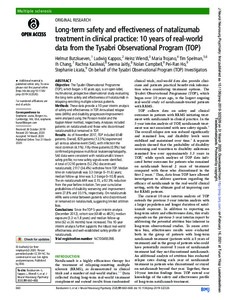Long-term safety and effectiveness of natalizumab treatment in clinical practice: 10 years of real-world data from the Tysabri Observational Program (TOP)
Helmut Butzkueven; Pei-Ran Ho; Seema Jaitly; Ludwig Kappos; Rachna Kasliwal; Maria Trojano; Nolan Campbell; Tim Spelman; Stephanie Licata; On behalf of the Tysabri Observational Program (TOP) Investigators; Heinz Wiendl; Ih Chang
https://urn.fi/URN:NBN:fi-fe2021042823083
Tiivistelmä
Objective: The Tysabri Observational Programme (TOP), which began >10 years ago, is an open-label, multinational, prospective observational study evaluating the long-term safety and effectiveness of natalizumab in relapsing-remitting multiple sclerosis patients.
Methods: These data provide a 10-year interim analysis of safety and effectiveness in TOP. Annualised relapse rates (ARRs) and disability progression/improvement were analysed using the Poisson model and the Kaplan-Meier method, respectively. Analyses included patients on natalizumab and those who discontinued natalizumab but remained in TOP.
Results: As of November 2017, TOP included 6148 patients. Overall, 829 patients (13.5%) experienced ≥1 serious adverse event (SAE), with infection the most common (4.1%). Fifty-three patients (0.9%) had confirmed progressive multifocal leukoencephalopathy. SAE data were consistent with natalizumab's known safety profile; no new safety signals were identified. A total of 3210 patients (52.2%) discontinued natalizumab; 2117 (34.4%) withdrew from TOP. Median time on natalizumab was 3.3 (range 0-11.6) years; median follow-up time was 5.2 (range 0-10.8) years. The on-natalizumab ARR was 0.15, a 92.5% reduction from the year before initiation. Ten-year cumulative probabilities of disability worsening and improvement were 27.8% and 33.1%, respectively. On-natalizumab ARRs were similar between patients who discontinued or remained on natalizumab, suggesting limited attrition bias.
Conclusions: Since the TOP 5-year interim analysis (December 2012), cohort size (6148 vs 4821), median exposure (3.3 vs 1.8 years) and median follow-up time (62 vs 26 months) have increased. This 10-year interim analysis further supports the robust real-world effectiveness and well-established safety profile of natalizumab.
Kokoelmat
- Rinnakkaistallenteet [19248]
